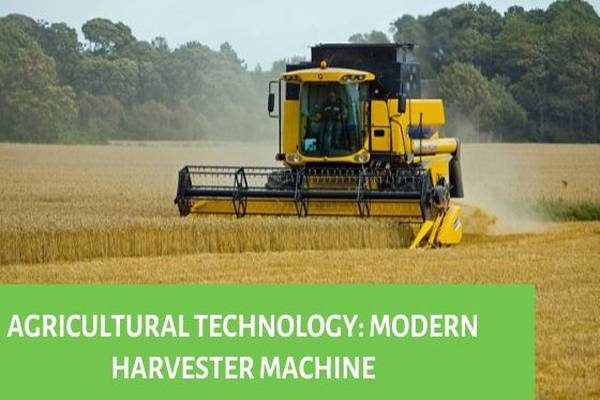Detail About Harvesting Equipment
Drafted by: vijaychourey26@gmail.com
In the vast fields of agriculture, harvesting equipment plays a crucial role in reaping the fruits of farmers' labor. Gone are the days when harvesting was a labor-intensive and time-consuming process. Today, modern harvesting equipment has become the backbone of the agricultural industry, offering efficiency, precision, and increased productivity. In this article, we will explore the world of harvesting equipment, delve into its various types, and examine its significance in the present and future of agriculture.
Harvesting equipment refers to the specialized machinery designed to harvest crops efficiently and effectively. These machines have replaced traditional manual harvesting methods, making the process more streamlined and less labor-intensive. Harvesting equipment can handle various types of crops, from grains and vegetables to fruits and cotton.
Types Of Harvesting Equipment
- Combine Harvesters
One of the most common types of harvesting equipment is the combine harvester. Combines can perform several tasks in a single operation, including cutting, threshing, and cleaning the harvested crop. They are widely used for harvesting grains like wheat, corn, and soybeans.
- Forage Harvesters
Forage harvesters are specialized machines used to harvest and chop silage crops such as corn, grass, and sorghum. Silage is a vital feed for livestock, and forage harvesters ensure its efficient collection and preservation.
- Cotton Harvesters
Cotton harvesters are designed specifically for picking cotton from the plants, minimizing manual labor and speeding up the harvesting process. These machines gently remove the cotton from the bolls, preserving the quality of the fibers.
- Potato Harvesters
Potato harvesters are used to dig up potatoes from the soil, separate them from the roots, and collect them in a hopper. These machines prevent damage to the potatoes during harvesting and are widely used in large-scale potato farming.
- Grape Harvesters
Grape harvesters have revolutionized the wine industry by streamlining the grape-picking process. These machines carefully collect the grapes without damaging the vines, ensuring a higher quality yield for winemaking.
- Tree Shakers
Tree shakers are employed in fruit orchards to shake the trees gently, causing the ripe fruits to fall onto collection sheets. This process ensures the efficient harvesting of fruits such as apples, cherries, and olives.
How Harvesting Equipment Works
The working principle of harvesting equipment varies depending on the type of machine. Combine harvesters, for example, use a cutting mechanism to harvest the crop and then separate the grain from the chaff through a threshing process. On the other hand, cotton harvesters have rotating spindles that pick the cotton from the plants. Each type of harvester is engineered to suit the specific crop it handles, optimizing the harvesting process.
Advantages Of Using Harvesting Equipment
- Increased Efficiency
The use of harvesting equipment significantly boosts the efficiency of the harvesting process. With the ability to cover large areas in a short time, these machines enable farmers to complete their harvests quickly.
- Time and Labor Savings
Manual harvesting is labor-intensive and time-consuming. Harvesting equipment automates the process, reducing the need for manual labor and allowing farmers to focus on other essential farm tasks.
- Reduced Crop Loss
Modern harvesting machines are designed to minimize crop losses during harvesting. They handle crops gently and effectively, reducing the risk of damage and spoilage.
Factors To Consider When Choosing Harvesting Equipment
- Crop Type
Different crops require specific harvesting equipment. Farmers must choose machines that are suitable for the crops they grow to ensure optimal performance.
- Farm Size
The size of the farm plays a crucial role in determining the type and size of harvesting equipment required. Larger farms may need more advanced and larger machines to cover the extensive areas efficiently.
- Budget
Harvesting equipment can vary significantly in price. Farmers should consider their budget and invest in machines that offer the best value for their specific needs.
- Maintenance and Service
Regular maintenance is essential to keep harvesting equipment in peak condition. Farmers should consider the availability of service and support when choosing machinery.
Tips For Proper Maintenance Of Harvesting Equipment
Maintaining harvesting equipment is essential to prolong its lifespan and ensure optimal performance. Here are some tips for proper maintenance:
Regularly clean the equipment to remove dirt and debris that can affect its operation.
Keep all moving parts well-lubricated to reduce friction and prevent premature wear and tear.
Conduct regular inspections to identify and address any potential issues before they become major problems.
Store the equipment in a dry and covered area when not in use to protect it from the elements.
Innovations In Harvesting Equipment
Advancements in technology have led to several innovations in the field of harvesting equipment. These innovations aim to improve efficiency, reduce environmental impact, and enhance overall performance. Some notable innovations include:
- GPS Technology Integration
GPS technology allows for precise navigation and mapping of the fields, enabling harvesting equipment to operate with pinpoint accuracy. This integration helps optimize harvesting routes, reduce overlaps, and minimize fuel consumption.
- Autonomous Harvesters
The future of harvesting equipment lies in autonomy. Autonomous harvesters use sensors and artificial intelligence to operate without human intervention, maximizing efficiency and reducing the need for manual labor.
Environmental Impact Of Harvesting Equipment
While harvesting equipment offers numerous benefits, it also has some environmental implications. Two significant factors to consider are fuel consumption and emissions. To mitigate the environmental impact, farmers can adopt sustainable practices and use advanced equipment with eco-friendly features.
Future Trends In Harvesting Equipment
- Robotics and AI
Harvesting equipment is increasingly incorporating robotics and AI technologies to improve precision and decision-making. These advancements will enhance crop yield and reduce waste.
- Precision Agriculture
The concept of precision agriculture involves using data, sensors, and technology to optimize farming practices. Harvesting equipment will be an integral part of this approach, providing real-time data and insights for better decision-making.








